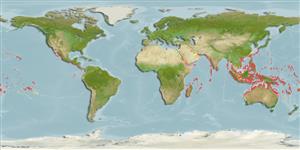Common names from other countries
>
Eupercaria/misc (Various families in series Eupercaria) >
Labridae (Wrasses) > Cheilininae
Etymology: Novaculichthys: Latin, novacula = razor + Greek, ichthys = fish (Ref. 45335).
More on author: Lacepède.
Environment: milieu / climate zone / depth range / distribution range
Ecología
marino asociado a arrecife; rango de profundidad 3 - 25 m (Ref. 30573), usually ? - 14 m (Ref. 27115). Tropical; 24°C - 28°C (Ref. 27115); 30°N - 30°S, 32°E - 77°W
Indo-Pacific: Red Sea to South Africa (Ref. 35918) and the Tuamoto Islands, north to Ryukyu and Hawaiian islands, south to Lord Howe Island. Excluding Persian Gulf (Ref. 86689). Eastern Pacific: Gulf of California to Panama and the Galapagos Islands (Ref. 5227).
Tamaño / Peso / Age
Maturity: Lm ? range ? - ? cm
Max length : 30.0 cm TL macho / no sexado; (Ref. 2334)
Short description
Claves de identificación | Morfología | Morfometría
Espinas dorsales (total) : 9; Radios blandos dorsales (total) : 12 - 13; Espinas anales: 3; Radios blandos anales: 12 - 13. Juveniles have long extended dorsal fin spines (Ref. 48636).
Inhabit semi-exposed reef flats and lagoon and seaward reefs (Ref. 1602). Common in areas of mixed sand, and rubble that are subject to mild surge (Ref. 1602, 58466). Benthopelagic (Ref. 58302). Juveniles shallow on rubble amongst large bommies or protected open patches on reef crests and swim as if were a leaf floating along the bottom; large adults move along over large reef section, usually in pairs and typically turn or shift large pieces of rubble or debris that they grab and pull with their mouth or push over with their snout. Often, while one works the piece, the other grabs exposed prey. They are sometimes called rock-mover wrasse, but they don't move real rocks (Ref. 48636). Highly territorial (Ref. 9823). Feed on mollusks, sea urchins, brittle stars, polychaetes, and crabs (Ref. 5213); feeding is done by overturning large rocks to expose target preys. The young imitate drifting masses of algae (Ref. 2334). Marketed fresh (Ref. 9311). Minimum depth reported from Ref. 30874.
Life cycle and mating behavior
Maturities | Reproducción | Spawnings | Egg(s) | Fecundities | Larva
Oviparous, distinct pairing during breeding (Ref. 205).
Randall, J.E., G.R. Allen and R.C. Steene, 1990. Fishes of the Great Barrier Reef and Coral Sea. University of Hawaii Press, Honolulu, Hawaii. 506 p. (Ref. 2334)
IUCN Red List Status (Ref. 130435)
CITES (Ref. 128078)
Not Evaluated
Threat to humans
Harmless
Human uses
Pesquerías: escaso valor comercial; Acuario: Comercial
Herramientas
Special reports
Download XML
Fuentes de Internet
Estimates based on models
Preferred temperature (Ref.
115969): 24.9 - 29.3, mean 28.3 (based on 3357 cells).
Phylogenetic diversity index (Ref.
82804): PD
50 = 1.0000 [Uniqueness, from 0.5 = low to 2.0 = high].
Bayesian length-weight: a=0.01995 (0.01075 - 0.03703), b=2.96 (2.79 - 3.13), in cm Total Length, based on LWR estimates for this species & (Sub)family-body (Ref.
93245).
Nivel trófico (Ref.
69278): 3.3 ±0.40 se; based on food items.
Resiliencia (Ref.
120179): Medio, población duplicada en un tiempo mínimo de 1.4-4.4 años (Preliminary K or Fecundity.).
Fishing Vulnerability (Ref.
59153): Low vulnerability (20 of 100).
